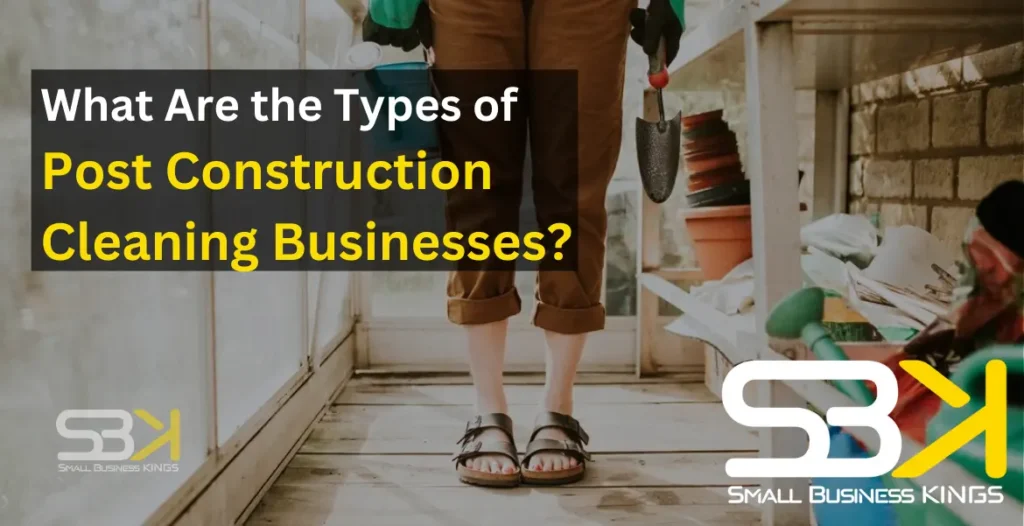Starting a construction project is exciting, but the aftermath often leaves behind debris, dust, and safety hazards that require expert attention. This is where cleanup services after construction come in, transforming newly built or renovated spaces into pristine, move-in-ready environments. These businesses handle tasks such as debris removal, surface cleaning, and ensuring safety compliance, making them an integral part of the building process.
The demand for cleaning services post-construction is on the rise. According to IBISWorld, the U.S. cleaning services industry generates over $65 billion annually, with a significant portion attributed to construction cleanup. These businesses cater to diverse sectors, from residential and commercial projects to specialized facilities like hospitals and schools. By ensuring spaces are clean, safe, and visually appealing, post-construction cleaning services offer immense growth opportunities for entrepreneurs looking to enter this dynamic and essential industry.
Scope of Post Construction Cleaning
The scope of the post-renovation cleaning industry is vast and highly lucrative, catering to various sectors. It includes cleaning residential properties such as newly built homes and apartments, as well as commercial spaces like offices, retail stores, and industrial facilities. Specialized services are in demand for facilities like hospitals and schools, where strict hygiene standards must be met.
Construction cleanup businesses also partner with contractors to handle rough, light, and final cleaning phases, ensuring spaces are safe and ready for use. Eco-friendly services using sustainable products appeal to environmentally conscious clients, while the real estate market relies on these businesses to prepare properties for sale or lease.
The steady growth in construction and renovation projects creates consistent opportunities, making this industry a scalable and rewarding venture for entrepreneurs.
Types of Post-Construction Cleaning Services You Can Start
Residential Post-Construction Cleaning
Residential post-construction cleaning business focuses on preparing homes for occupancy after construction or renovation. It ensures the home is safe, clean, and aesthetically appealing. The services offered cover a comprehensive range of tasks designed to remove construction debris, dust, and residues, creating a welcoming environment.
Post construction house cleaning is essential in transforming a newly built or renovated property into a spotless and livable space, allowing homeowners to move in without worrying about any leftover mess.
1. Dust and Debris Removal
Dust and debris removal is a key part of residential cleaning after construction. This includes sweeping, vacuuming floors, walls, and ceilings to remove construction dust, and wiping down surfaces like countertops and furniture.
Industrial-grade vacuums with HEPA filters capture fine dust particles, while microfiber cloths and dusters are used to remove surface dust without spreading it. These techniques ensure the home is clean, safe, and ready for occupancy.
2. Window and Glass Cleaning
Window and glass cleaning involves cleaning both the interior and exterior glass panes, window sills, and frames. It also includes removing stickers, paint splashes, and construction residue from glass surfaces.
To ensure a clean and scratch-free result, non-abrasive scrapers are used to carefully remove stubborn marks, while streak-free cleaning solutions are applied with squeegees for a polished finish. This process leaves windows crystal clear, enhancing the overall appearance of the space.
3. Floor Cleaning and Polishing
Floor cleaning and polishing involves cleaning and sanitizing floors made from various materials such as wood, tiles, or carpet. It includes removing stains, grout residue, and construction adhesives. For hardwood floors, dry mopping is followed by polishing with wood-safe cleaners to maintain their shine.
Tiled floors are cleaned with grout scrubbing and steam cleaning to restore their appearance. Carpets are deep cleaned using hot water extraction or vacuumed with powerful suction equipment to remove debris and stains. These techniques ensure that floors are spotless and properly maintained after construction.
4. Kitchen and Bathroom Cleaning
Kitchen and bathroom cleaning involves thoroughly cleaning appliances, cabinets, countertops, sinks, and faucets in the kitchen, as well as disinfecting bathtubs, toilets, mirrors, and tiles in the bathroom.
Mild, non-toxic cleaning agents are applied to protect sensitive surfaces, while scrub brushes and sponges are used to tackle stubborn grime, especially on tiles and grout. This ensures that all kitchen and bathroom areas are sanitized, spotless, and safe for use after construction.
5. Fixture and Vent Cleaning
Fixture and vent cleaning involves cleaning light fixtures, ceiling fans, and air vents to ensure they are free from dust and construction residue. Electrical outlets and switch plates are also cleaned to remove any debris.
Delicate fixtures are dusted and wiped with lint-free cloths to avoid scratches, while vents are vacuumed and sanitized to maintain proper airflow and cleanliness. This process ensures that all fixtures and vents are functioning efficiently and free from construction remnants.
6. Paint and Adhesive Residue Removal
Paint and adhesive residue removal involves eliminating paint splashes, adhesive tape residue, and caulking remnants from various surfaces. Specialized cleaning solvents are used to dissolve adhesives safely, ensuring no damage to the surface.
Plastic scrapers are employed to remove stubborn residue without scratching or harming the material. This process ensures a clean, smooth finish, free from any leftover construction materials.
7. Waste Disposal and Recycling
Waste disposal and recycling involves the proper removal of construction debris, packing materials, and leftover supplies, ensuring compliance with local regulations. The process includes the segregation of recyclable materials from general waste, using heavy-duty garbage bags and bins for efficient collection.
To promote sustainability, cleaning services often partner with local recycling facilities to ensure that as much material as possible is repurposed or disposed of responsibly. This not only helps maintain cleanliness but also contributes to environmental conservation.
Commercial Post-Construction Cleaning
Commercial cleaning after construction focuses on large spaces such as offices, retail establishments, and industrial facilities. These areas require specific techniques and equipment to comply with industry standards and regulations.
This service is critical for businesses, helping them maintain hygiene, adhere to safety codes, and prepare spaces for operation. Here’s a breakdown of the key components involved in commercial post-construction cleaning:
1. Dust and Debris Removal
Cleaning large areas, including floors, walls, and ceilings, from construction dust, debris, and other particles left behind.
Industrial-grade vacuums with HEPA filters are employed to capture fine dust particles. Microfiber dusters and cloths are used to wipe down surfaces and reduce dust without spreading it around.
2. Floor Cleaning and Polishing
Cleaning floors made of various materials (wood, tiles, concrete, carpet) and removing stains, adhesives, and grout residue.
For hard floors like tile or concrete, power scrubbing and steam cleaning are common. Carpets are cleaned using commercial hot water extraction or heavy-duty vacuuming to remove deep-set dirt and debris.
3. Window and Glass Cleaning
Cleaning windows, glass doors, and partitions in commercial spaces, ensuring no streaks or residues remain.
Commercial-grade glass cleaners and squeegees are used to leave a streak-free shine. For stubborn residue like paint or adhesive, non-abrasive scrapers are utilized to avoid scratching the glass.
4. Restroom and Kitchen Area Cleaning
Deep cleaning of restrooms and kitchen areas, including countertops, sinks, faucets, and toilets. Strong disinfectants are used to sanitize high-touch areas like faucets and door handles. For kitchens, surface cleaners and degreasers are used to remove cooking residues and grease build-up.
5. HVAC and Vent Cleaning
Cleaning air vents, ducts, and HVAC systems to eliminate dust and debris, ensuring proper air circulation. Powerful vacuums and air-blowing tools are used to clean ducts. Vents and air grilles are wiped down with microfiber cloths to remove dust.
6. Hazardous Waste and Chemical Disposal
Handling the removal of hazardous materials like chemicals, paints, and solvents that are often left behind after construction. Special safety equipment, such as gloves, masks, and spill kits, are used to safely handle and dispose of hazardous materials according to local environmental regulations.
7. Waste Removal and Recycling
Disposing of construction debris, packing materials, and other refuse. Waste is segregated into recyclables and non-recyclables. Heavy-duty bags, bins, and dumpsters are used for efficient collection and removal. Partnering with recycling centers ensures the proper disposal of recyclable items.
8. Final Touches
Ensuring all areas are thoroughly cleaned, ensuring the space is ready for use or occupancy. After the heavy-duty cleaning, a final inspection is done to ensure that all surfaces are free from dirt, smudges, and streaks, leaving the space spotless and move-in ready.
Specialized Cleaning Services
Specialized cleaning services after construction cater to unique industries, such as medical facilities and educational institutions. These spaces require high-level cleaning standards due to health, safety, and regulatory compliance. Here’s a detailed breakdown of what these specialized services include and the techniques used:
1. Medical Facility Cleaning
Healthcare facilities demand the highest standards of hygiene and sanitation. Final cleaning for these spaces includes disinfection, waste disposal, and adherence to health regulations.
2. Educational Institution Cleaning
Schools and universities require safe, clean environments for students and staff. Specialized services focus on thorough cleaning after construction or renovations.
Phases of Post-Construction Cleaning
Rough Cleaning: Rough cleaning begins immediately after construction. It involves removing large debris, dust, and leftover materials such as nails or wood pieces, ensuring the site is ready for detailed cleaning.
Light Cleaning: Light cleaning is the second phase and includes dusting surfaces, cleaning light fixtures, and sanitizing appliances. This phase ensures all areas are free from visible dirt and grime.
Final Cleaning: The final cleaning stage is about perfection. Tasks like polishing floors, washing windows, and deep-cleaning carpets ensure the property looks impeccable and ready for occupancy.
Eco-Friendly Post-Construction Cleaning Services
In recent years, eco-friendly cleaning has gained popularity. These services use non-toxic cleaning products, sustainable practices, and energy-efficient equipment. Not only do they reduce environmental impact, but they also promote healthier indoor air quality, making them a preferred choice for many clients.
Conclusion
Post-construction cleaning is not simply about cleaning up; it’s about enhancing the safety, functionality, and aesthetics of a space. Whether you’re considering residential, commercial, or specialized cleaning services, each type has its own advantages and challenges. Each service caters to a specific market, with its own set of requirements, techniques, and equipment.
FAQs
- What is the role of construction cleanup businesses?
Construction cleanup businesses prepare newly built or renovated spaces for occupancy by removing debris, dust, and construction residue. - Why is deep cleaning post construction important?
Deep cleaning post construction eliminates leftover dust and debris, ensuring the home is clean, safe, and ready for occupancy. - What is post construction window cleaning?
Post construction window cleaning removes dust, smudges, and debris from windows after construction, leaving them spotless and clear. - Are eco-friendly cleaning options more expensive?
While some eco-friendly products may have a higher upfront cost, they offer long-term savings and health benefits. - What challenges do construction site cleaning businesses face?
Challenges include managing hazardous materials, meeting tight deadlines, and ensuring compliance with industry regulations.




